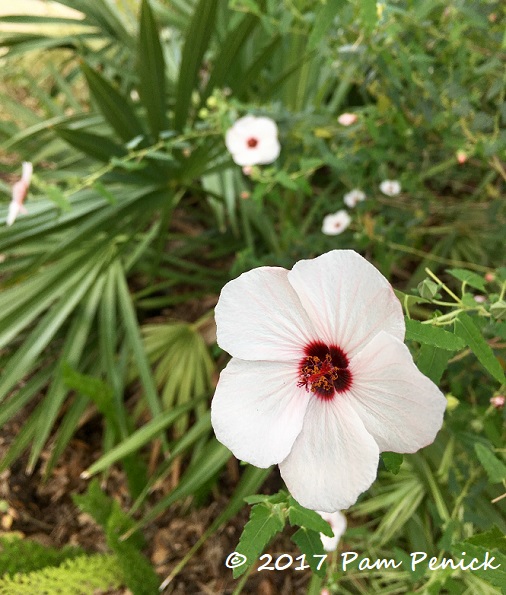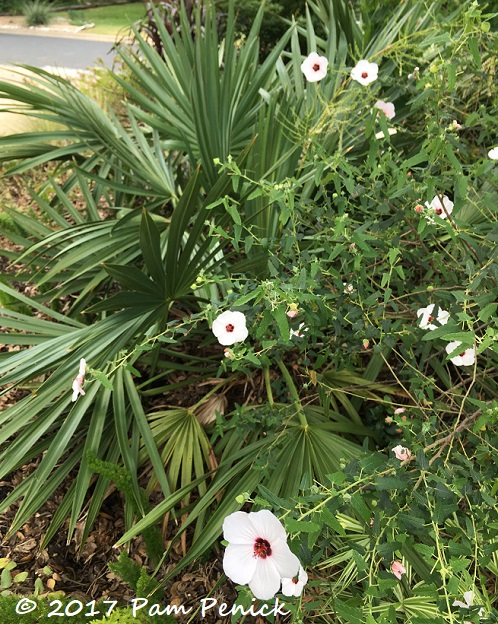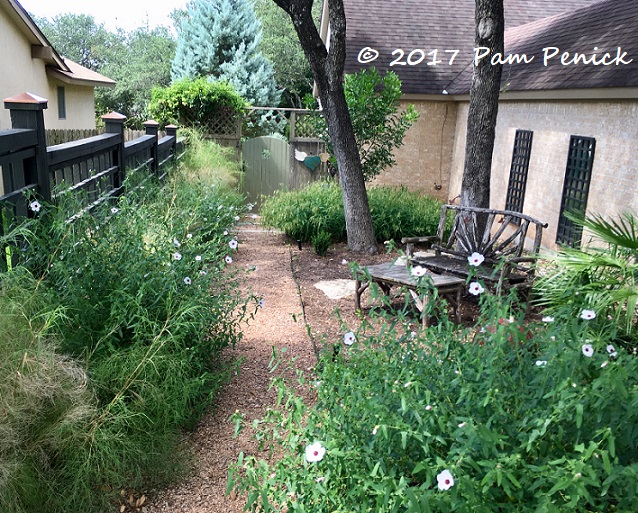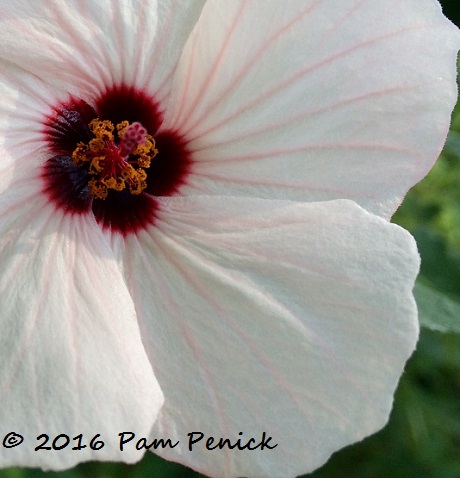Plant This: Pale pavonia, or Brazilian rock rose
Even in gentler months, my shady garden is not particularly flowery, and in the heat of summer those perennials that do flower — salvias, mistflowers, cupheas — tend to hunker down until fall. One happy exception is pale pavonia, also known as Brazilian rock rose (Pavonia hastata), a cousin to our native hot-pink rock rose (Pavonia lasiopetala). Its tissuey, hibiscus-like white flowers with wine-red eyes and veins bloom all summer on rangy stems of narrow, toothy leaves.
Impervious (in my garden, anyway) to deer, it handles the dry shade of live oaks with aplomb. In the island bed in the driveway, I’ve paired it with our native palmetto (Sabal minor), ‘Sparkler’ sedge, and foxtail fern (Asparagus meyeri). There’s also a burgundy-leaved loropetalum in the mix, which I think will look great with the pale pavonia’s red eyes, if it would only grow.
In the side garden, I replaced my original low hedge of flame acanthus, which was continually browsed by deer, with pale pavonia, which blooms reliably amid bamboo muhly (Muhlenbergia dumosa), inland sea oats (Chasmanthium latifolium), and a Mediterranean fan palm (Chamaerops humilis) on the right. (And if you’re curious about the blue tree behind the fence, that’s a ‘Blue Ice’ Arizona cypress, one of my favorite trees for that icy-blue color, pyramidal shape, and a Christmasy fragrance.)
Pale pavonia tends to seed out in the garden, but I find its seedlings easy to pull up after a rain, or you can transplant them around your garden. It can be a little cold tender, so I recommend planting it in spring, not fall. Dave’s Garden says it’s hardy to zone 7a, which I’m a little dubious about, but maybe in a warm microclimate. It grows to about 4 feet tall and wide in my garden, with a rangy appearance, kind of like Turk’s cap.
As MSS of Zanthan Gardens noted in a long-ago but useful blog post (she first inspired me to try pale pavonia 10 years ago), some of the flowers in spring and early summer are cleistogamous — i.e., they produce seeds without opening — so you may watch expectantly, awaiting a flush of flowers, only to be disappointed. Be patient. The glowing white flowers will light up the shade by midsummer through fall.
Note: My Plant This posts are written primarily for gardeners in central Texas. The plants I recommend are ones I’ve grown myself and have direct experience with. I wish I could provide more information about how these plants might perform in other parts of the country, but gardening knowledge is local. Consider checking your local online gardening forums to see if a particular plant might work in your region.
I welcome your comments; please scroll to the end of this post to leave one. If you’re reading this in a subscription email, click here to visit Digging and find the comment box at the end of each post.
_______________________
Digging Deeper: News and Upcoming Events
Get on the mailing list for Garden Spark Talks. Inspired by the idea of house concerts, I’m hosting a series of garden talks by talented designers and authors out of my home. Talks are limited-attendance events and generally sell out within just a few days, so join the Garden Spark email list for early notifications. Simply click this link and ask to be added.
All material © 2006-2017 by Pam Penick for Digging. Unauthorized reproduction prohibited.







What an interesting plant. It does look a bit like a hardy hibiscus that I have in my garden.
You have hardy hibiscus in Indiana? I had no idea! —Pam
I have several of the pale pavonia in my garden and I expect that somewhere along the line they came from your garden. I remember we talked about the cleistogamy in spring when you had lots of buds but they never opened to flowers. I have several cleistogamous plants. One other is also a native orange mallow which I understand does more of this during cold weather. The mallow family are prone to this behavior. The other is a violet. It rarely produces more than a couple of flowers but hundreds of these cleistogamous buds and is quite a pest. I would love to have a spring violet that really behaves as they should.
You’re right — I’ve noticed this with mallows too. Both are worth the wait, I find. —Pam
Pam, thank you for sharing the info about cleistogamous plants! I wondered what was going on with my Brazilian rock rose this spring and now I know! Mine seeds out like crazy and I get to share with friends and pass them on at garden club meetings too. Not many things are blooming so profusely this time of year, but this plant is a real champ in our heat!
It’s a trouper, for sure. I’m glad you’re enjoying it too, Melody. —Pam
Ah-ha! I was sure I was just “imagining things” but now I see it is a real thing–cleistogamous! Thanks for enlightening. I don’t remember what plant had me thinking–Shouldn’t it have bloomed by now—or maybe did it bloom and I missed it? But next time I have this passing thought about a plant with buds on it, I’ll know to keep an eye on it better.:-)
And then there are the deer. They’ve snacked on everything I’ve had out front that blooms except pink salvia, Henry Duelberg mealy sage, thryallis, Nuevo Leon salvia, and Hot lips salvia. I’ve experimented this year with firecracker bush, Big Bend acanthus, and bee brush, plus they snacked on Mexican Mint Marigold and lantana I’ve had for years (I know, I know–there’s no guarantees on “deer resistant”). Need to try Brazilian rock rose and the native pink rock rose out front–especially because they have such beautiful blooms. Thanks for the idea!
I really have wanted to try an Arizona cypress, too, as a screening plant but I could just see it getting spider mites right when it got to the ideal size and there goes my living screen. Any trick to keeping yours spider mite free and beautiful?
Deer are such a challenge, and in every part of town or area they seem willing to try different plants — just to keep us all on our toes, I’m sure. I hope the pavonia works out for you.
I haven’t had any problems with spider mites on my Arizona cypress. I just did a little research online, and it suggested that a hot, sunny location with good drainage is key to keeping them healthy. —Pam
I like this plant too. I planted one and the next year I had them all over the garden! I’m going to move some to the front next year and see if it can hold up to the deer traffic.
I hope your deer leave it alone too, Shirley. —Pam
I just found your site! Lucky me! 🙂 I’m an avid gardener in Austin as well. I planted a few of these rock rose plants last year and have been confused as to why there are so many buds, but so few flowers this spring. I’ve never heard of “cleistogamous”. Thanks for the information! Will be a follower!
You’re welcome! It is a confusing plant in that regard. You should see plenty of flowers by mid-summer and fall. —Pam